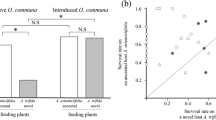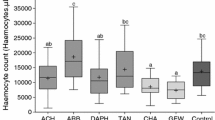Abstract
It is widely assumed that in the late nineteenth century Lobesia botrana Den. and Schiff. shifted its food source from a wild shrub (Daphne gnidium L.) to vine (Vitis vinifera L.). We explored if host range expansion reflects an evolutionary host shift, whereby the new moth-host association was linked to adaptive changes. The reaction norms of larval survival, adult weight and development time were investigated in L. botrana under field conditions. Two moth strains were established from vine and daphne, and reciprocal infestations with neonate larvae were performed on both host plants over the three larval generations. All three traits showed phenotypic plasticity and genetic variation, variation for plasticity being only detected in larval survival. Comparisons between hosts within strains showed that (1) larval survival was higher on vine in 9 of 12 cases, (2) adult weight was lower on vine only in the first generation and (3) development time was shorter on vine in first generation, shorter on daphne in third generation and displayed a sex-related response in the second generation. Comparisons between strains within hosts evidenced moth-host adaptation as larval survival increased when strains developed on its original host. There was also evidence of moth-parasitoid coevolution because parasitism level was strain-dependent. We hypothesize that higher larval survival on vine, similar adult weight on both hosts in summer generations and lower predation risk in vineyards, might be among the fitness-related factors explaining evolutionary host shift to and worldwide adaptive success on vine of L. botrana.


Similar content being viewed by others
References
Agosta SJ (2006) On ecological fitting, plant-insect associations, herbivore host shifts, and host plant selection. Oikos 114:556–565
Baggiolini M (1952) Les stades repères dans le développement annuel de la vigne et leur utilisation pratique. Rev Romande Agric Vitic Arboric 8:4–6
Baillod M, Baggiolini M (1993) Les stades rèperes de la vigne. Rev Suisse Vitic Arboric Hortic 25:7–9
Balachowsky AS, Mesnil L (1935–1936) Les insectes nuisibles aux plantes cultivées (2 vol.). Busson-L Méry, Paris
Bernays EA, Graham M (1988) On the evolution of host specificity in phytophagous arthropods. Ecology 69:886–892
Berrigan D, Charnov EL (1994) Reaction norms for age and size at maturity in response to temperature: a puzzle for life historians. Oikos 70:474–478
Bovey P (1966) Super-famille des Tortricoidea. In: Balachowsky AS (ed) Entomologie appliquée à l’agriculture, 2 (1). Masson et Cie, Paris, pp 456–893
Coscollá R (1997) La polilla del racimo de la vid (Lobesia botrana Den. y Schiff.). Generalitat Valenciana, Conselleria de Agricultura, Pesca y Alimentación, Paterna (Valencia)
Cuní y Martorell M (1874) Catálogo metódico y razonado de los lepidópteros que se encuentran en los alrededores de Barcelona, de los pueblos cercanos y de otros lugares de Cataluña. T. Gorchs, Barcelona
Danks HV (2002) Modification of adverse conditions by insects. Oikos 99:10–24
Eichhorn KW, Lorenz DH (1977) Phänologische entwicklungsstadien der rebe. Nachrichtenblatt des Deutschen Pflanzenschutzdienstes (Braunschweig) 29:119–120
Fermaud M (1998) Cultivar susceptibility of grape berry clusters to larvae of Lobesia botrana (Lepidoptera: Tortricidae). J Econ Entomol 91:974–980
Fox CW, Czesak ME (2000) Evolutionary ecology of progeny size in arthropods. Annu Rev Entomol 45:341–369
Fusco G, Minelli A (2010) Phenotypic plasticity in development and evolution: facts and concepts. Phil Trans R Soc B 365:547–556
Gabel B, Roehrich R (1995) Sensitivity of grapevine phenological stages to larvae of European grapevine moth, Lobesia botrana Den. et Schiff. (Lep., Tortricidae). J Appl Entomol 119:127–130
Gotthard K (2000) Increased risk of predation as a cost of high growth rate: an experimental test in a butterfly. J Anim Ecol 69:896–902
Grassé PP (1928) Eudémis et plantes sauvages. Prog Agric Vitic 90(49):541–544
Hanski IA, Gilpin ME (eds) (1997) Metapopulation biology: ecology, genetics, and evolution. Academic Press, London
Hunter AF, Elkinton JS (2000) Effects of synchrony with host plant on populations of a spring-feeding lepidopteran. Ecology 81:1248–1261
Ioriatti C, Anfora G, Tasin M, De Cristofaro A, Witzgall P, Lucchi A (2011) Chemical ecology and management of Lobesia botrana (Lepidoptera: Tortricidae). J Econ Entomol 104:1125–1137
Jermy T (1984) Evolution of insect/host plant relationship. Am Nat 124:609–630
Lucchi A, Santini L (2011) Life history of Lobesia botrana on Daphne gnidium in a Natural Park of Tuscany. IOBC 67:197–202
Maher N, Thiéry D (2006) Daphne gnidium, a possible native host plant of the European grapevine moth Lobesia botrana, stimulates its oviposition. Is a host shift relevant? Chemoecology 16:135–144
Marchal P (1912) Rapport sur les travaux accomplis par la mission d’étude de la Cochylis et de l’Eudémis pendant l’année 1911. Béranger, Paris
Martín-Vertedor D, Ferrero-García JJ, Torres-Vila LM (2010) Global warming affects phenology and voltinism of Lobesia botrana in Spain. Agric Forest Entomol 12:169–176
Masante-Roca I, Anton S, Delbac L, Dufour MC, Gadenne C (2007) Attraction of the grapevine moth to host and non-host plant parts in the wind tunnel: effects of plant phenology, sex, and mating status. Entomol Exp Appl 122:239–245
Mercader RJ, Scriber JM (2005) Phenotypic plasticity in host selection in adult tiger swallowtail butterflies, Papilio glaucus (Lepidoptera: Papilionidae). In: Ananthakrishnan TN (ed) Insects and phenotypic plasticity. IHB, Oxford, pp 25–57
Millière P (1875) Catalogue raisonné des Lépidoptères [du Département] des Alpes-Maritimes [III]. Mém Soc Sci Nat Hist Lett Beaux-Arts Cannes Arrondissement Grasse 5:51–216
Mondy N, Corio-Costet MF (2004) Feeding insects with a phytopathogenic fungus influences their diapause and population dynamics. Ecol Entomol 29:711–747
Mondy N, Charrier B, Fermaud M, Pracros P, Corio-Costet MF (1998) A mutualism between a phytopathogenic fungus (Botrytis cinerea) and a vineyard pest (Lobesia botrana): positive effects on insect development and oviposition behaviour. Cr Acad Sci Paris, Ser Sci Vie 321:665–671
Moreau J, Benrey B, Thiéry D (2006a) Grape variety affects larval performance and also female reproductive performance of the European grapevine moth (Lobesia botrana). Bull Entomol Res 96:205–212
Moreau J, Benrey B, Thiéry D (2006b) Assessing larval food quality for phytophagous insects: are the facts as simple as they appear? Funct Ecol 20:592–600
Moreau J, Thiéry D, Troussard JT, Benrey B (2007) Grape variety affects female but also male reproductive success in wild European grapevine moths. Ecol Entomol 32:747–753
Nuzzaci G, Triggiani O (1982) Note sulla biocenosi in Puglia della Lobesia (Polychrosis) botrana (Schiff.) (Lepidoptera: Tortricidae) infeudata a Daphne gnidium L. Entomologica 17:47–52
Nylin S, Gotthard K (1998) Plasticity in life history traits. Annu Rev Entomol 43:63–83
Paré PW, Tumlinson JH (1999) Plant volatiles as a defense against insect herbivores. Plant Physiol 121:325–331
Pavan F, Stefanelli G, Cargnus E, Villani A (2009) Assessing the influence of inflorescence traits on the susceptibility of grape to vine moths. J Appl Entomol 133:394–401
Pigliucci M (2001) Phenotypic plasticity: beyond nature and nurture. John Hopkins University Press, Baltimore
Roehrich R, Boller E (1991) Tortricids in vineyards. In: van der Geest LPS, Evenhuis HH (eds) Tortricids pests their biology, natural enemies and control. Elsevier, Amsterdam, pp 507–514
Roehrich R, Carles JP (1981) Observations sur les déplacements de l’Eudémis, Lobesia botrana. Boll Zool Agrar Bach, Ser II 16:10–11
Savopoulou-Soultani M, Stavridis DG, Vassiliou A, Stafilidis JE, Iraklidis I (1994) Response of Lobesia botrana (Lepidoptera: Tortricidae) to levels of sugar and protein in artificial diets. J Econ Entomol 87:84–90
Schmitz V, Roehrich R, Stockel J (1996) Dispersal of marked and released adults of Lobesia botrana in an isolated vineyard and the effect of synthetic sex pheromone on their movements. J Int Sci Vigne Vin 30:67–72
Scriber JM, Slansky F (1981) The nutritional ecology of immature insects. Annu Rev Entomol 26:183–211
Singer MS, Rodrigues D, Stireman JO III, Carrière Y (2004) Roles of food quality and enemy-free space in host use by a generalist insect herbivore. Ecology 85:2747–2753
Sokal RR, Rohlf FJ (1995) Biometry. Freeman and Co, New York
Stamp NE, Casey TE (1993) Caterpillars: ecological and evolutionary constraints on foraging. Chapman and Hall, London
Stearns SC (1989) The evolutionary significance of phenotypic plasticity. Bioscience 39:436–445
Stearns SC (1992) The evolution of life histories. Oxford University Press, Oxford
Stockel J, Roehrich R, Carles JP, Nadaud A (1989) Technique d’élevage pour l’obtention programmée d’adultes vierges d’Eudémis. Phytoma 412:45–47
Stoeva R (1982) Food-plants of the grape moth (Lobesia botrana Schiff.) in Bulgaria [in Bulgarian]. Grad Loz Nauka 19:83–89
Systat (2000) Systat 10.0 The system for statistics. System Software Inc, Richmond, California
Tasin M, Bäckman AC, Anfora G, Carlin S, Ioriatti C, Witzgall P (2010) Attraction of female grapevine moth to common and specific olfactory cues from two host plants. Chem Senses 35:57–64
Thiéry D (2005) Les vers de la grappe: les connaître pour s’en protéger. Vignes et Vins International Publications, Bordeaux
Thiéry D, Moreau J (2005) Relative performance of European grapevine moth (Lobesia botrana) on grapes and other hosts. Oecologia 143:548–557
Thompson JN (1988) Evolutionary ecology of the relationship between oviposition preference and performance of offspring in phytophagous insects. Entomol Exp Appl 47:3–14
Thompson JN (1994) The coevolutionary process. University of Chicago Press, Chicago
Torres-Vila LM (1996) Efecto de la temperatura de desarrollo preimaginal sobre el potencial biótico de la polilla del racimo de la vid, Lobesia botrana (Denis y Schiffermüller, [1775]) (Lepidoptera: Tortricidae). SHILAP Revta Lepid 24:197–206
Torres-Vila LM (2010) Lobesia botrana Den. and Schiff. (Lepidoptera: Tortricidae). Crop Protection Compendium. CABI Web. http://www.cabi.org/cpc. Accessed 8 September 2011
Torres-Vila LM, Rodríguez-Molina MC (2002) Egg size variation and its relationship with larval performance in the Lepidoptera: the case of the European grapevine moth Lobesia botrana. Oikos 99:272–283
Torres-Vila LM, Schmitz V, Stockel J (1992) Efecto de la evolución fenológica y de la variedad de vid en la instalación y supervivencia en primera generación de las orugas de la polilla del racimo (Lobesia botrana Den. y Schiff.; Lepidoptera: Tortricidae). Bol San Veg Plagas 18:755–764
Torres-Vila LM, Oustry L, Schmitz V, Roehrich R, Stockel J (1993) Acción de la humedad relativa y la fluctuación térmica sobre la crisálida no diapausante de la “polilla del racimo”, Lobesia botrana Den. y Schiff. (Lepidoptera: Tortricidae). Bol San Veg Plagas 19:79–92
Torres-Vila LM, Stockel J, Roehrich R (1995) Le potentiel reproducteur et ses variables biotiques associées chez le mâle de l’Eudémis de la vigne Lobesia botrana. Entomol Exp Appl 77:105–119
Torres-Vila LM, Stockel J, Roehrich R, Rodríguez-Molina MC (1997) The relation between dispersal and survival of Lobesia botrana larvae and their density in vine inflorescences. Entomol Exp Appl 84:109–114
Torres-Vila LM, Rodríguez-Molina MC, Roehrich R, Stockel J (1999) Vine phenological stage during larval feeding affects male and female reproductive output of Lobesia botrana (Lepidoptera: Tortricidae). Bull Entomol Res 89:549–556
Torres-Vila LM, McMinn M, Rodríguez-Molina A, Rodríguez-Molina MC (2006) Primera cita de Lobesia botrana Den. et Schiff. (Lepidoptera: Tortricidae) en la isla de Cabrera, Islas Baleares. Boll Soc Hist Nat Balears 49:45–49
Torres-Vila LM, Cruces Caldera E, Rodríguez-Molina MC (2012) Host plant selects for egg size in the moth Lobesia botrana: integrating reproductive and ecological trade-offs is not a simple matter. In: Cauterruccio L (ed) Moths: types, ecological significance and control methods. Nova Science Publication, Hauppauge
van Asch M, Visser ME (2007) Phenology of forest caterpillars and their host trees: the importance of synchrony. Annu Rev Entomol 52:37–55
Via S (1984) The quantitative genetics of polyphagy in an insect herbivore. I. Genotype-environment interaction in larval performance on different host plant species. Evolution 38:881–895
West SA, Cunningham JP (2002) A general model for host plant selection in phytophagous insects. J Theor Biol 214:499–513
Acknowledgments
We thank all members of the Integrated Protection team, E. Cruces Caldera, A. Sánchez González, D. Martín-Vertedor, F. Ponce Escudero, J.J. Ferrero García, and F. Barrena Galán for providing technical assistance in both the laboratory and field. We are very grateful to the owners of the experimental vineyards, M.A. Carranza and E. Silva, for their kind permission to conduct our investigations, and especially to Dr. M. Jennions for his valuable suggestions and for improving the English. We also appreciate the constructive labour of three anonymous reviewers to improve the original manuscript.
Author information
Authors and Affiliations
Corresponding author
Additional information
Handling Editors: Yvan Rahbe and Heikki Hokkanen.
Rights and permissions
About this article
Cite this article
Torres-Vila, L.M., Rodríguez-Molina, M.C. Host plant-mediated reaction norms in the European grapevine moth: evidence for evolutionary host shift from daphne to vine. Arthropod-Plant Interactions 7, 125–136 (2013). https://doi.org/10.1007/s11829-012-9233-0
Received:
Accepted:
Published:
Issue Date:
DOI: https://doi.org/10.1007/s11829-012-9233-0




